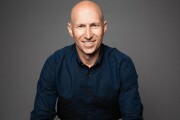Hamilton College
The issue, Wu explains, is not just a matter of wellness, but one of uncertainty. Not knowing how much time you or a loved one has left can drastically shift your long-term financial plans.
Because of that, Wu believes every advisor should be attuned to the role health plays in a client’s decision-making. He also expects health to become a more commonly discussed topic between advisors and investors as the ongoing pandemic continues to change people’s priorities.
“COVID has been something that has caused health uncertainty at a level even greater than prior health issues and health shocks that we might have faced,” Wu said. “So how has tolerance for risk changed? And how has willingness to plan for the future changed due to COVID? The pandemic has created a lot of challenges, but it has also made individual investors think more about the future.
“Maybe people are realizing their mortality even more, and the idea of planning for the future is even more in the forefront.”
Liquid and safe
Wu’s latest research paper on the subject was
He set out to determine how the health status of a person impacts the way they allocate their wealth. Wu said that theoretically, there were two reasonable hypotheses to be made before his work got started.
The first is that someone who is ill may prefer a liquid portfolio that provides more immediate access to their funds. Increased and often fluctuating medical expenses can present situations where clients need cash fast.
The second is more overarching and related to risk, Wu said. Battling prolonged illness is a source of uncertainty that may drive clients with adverse health to safer portfolios.
Wu said his results, supported by years of data from the
The study finds the percentages of single people tin excellent, very good, good, fair and poor health hat own a positive amount of risky assets are 19.1%, 19.5%, 13.2%, 7.3% and 6.8%, respectively.
Meanwhile, the share of financial wealth held in safe assets increases and the shares held in retirement accounts and risky assets decrease as health status deteriorates.
Single respondents who report themselves to be in excellent health hold 62% of their financial wealth in safe assets, 24.8% in retirement assets and 12.5% in risky assets, according to Wu’s study. Corresponding figures for those in poor health are 84.3%, 8.6%, and 6.6%.
But when looking at sudden health changes or “shocks,” the study determined that those events only modestly affect portfolio decisions. For single people, new onsets of illness do not impact asset ownership probabilities or the allocation of financial wealth.
A health shock was defined as a newly diagnosed onset of heart conditions, strokes, cancers or malignant tumors, lung diseases and diabetes.
Wu’s research also found that while a well-established research agenda focused on health and portfolio decisions does exist, there is still much to learn about the topic. He said one of the most important questions is why such a strong cross-sectional relationship between health and wealth allocation exists, while evidence documenting the causal effect of health shocks is so much weaker.
“It's a little bit harder to document that. One of the big reasons is you really have to follow people over time, and you have to sort of follow their health status over time,” Wu said. “You don't see as many people doing that are looking at that specific question. But less evidence doesn't mean that evidence doesn't exist at all.”
An exchange of expertise
Matthew G. Ricks said his passion for working with clients facing ongoing health challenges developed organically during the six years he spent as an advisor for both Wells Fargo and Ameriprise Financial.
The New York-based advisor came across a number of people who always had to consider their next doctor’s visit before making their next portfolio decision, and he wanted to do more to help.
“I wondered if there were advisors already doing this where I was kind of spinning my wheels,” he said. “I found through my research that there are some planners and advisors who are solely focused on this community, however there's not nearly enough. I started this career to help people and this is a major gap within the industry, so I decided to jump in.”
Ricks went independent and started
Part of that approach, Ricks said, is knowing what you don’t know. In other words, working with health-challenged clients should be an exchange of expertise.
While the advisor may be the expert in matters of money, the client is the foremost expert on their well-being, or the well-being of a loved one.
“I’m always up front, and I say I'm only two years into this process while a client may have been battling this for 15 years,” he said. “If you’re a parent and your child is autistic, you've done all the research. They know more than I do about specific programs and their specific situations. What I can then add to their situation is all the other knowledge as a planner.”
In terms of the impact COVID has had on his client base, Ricks says he is fortunate that no one he advises has been negatively impacted from a physical health perspective.
Mental health and quality of life, however, have become much more pressing.
“Over the past two years, people have seen how quickly things can turn, and a lot of people are saying, ‘Why am I delaying enjoying my life? I want to enjoy my life now,’” Ricks said. “So that change in mindset can lead to a change in finances.”
He added that one element of his work that is difficult to track with any dataset is the reward of helping someone facing a health hurdle clear it. He urges advisors to take on these clients and see the positive impact they can make.
“There are millions of people in the U.S. that have some sort of disability or special needs, and there are certainly nowhere near enough planners and advisors with the knowledge to really help these families and these individuals,” Ricks said. “I wish that more people did it.”
Managing more than money
Jon Dauphiné,
One initiative created to support vulnerable groups under Dauphiné’s direction is the FFP Pro Bono for Cancer Campaign. The program pairs financially struggling cancer patients and their families with experienced advisors who assist them at no cost.
Dauphiné said that client base is a crucial one to support because of the toll cancer can take on an individual's finances. He said in far too many cases, people battling cancer deplete their savings or raid their retirement accounts to maintain treatment.
“So even if they go into remission, they're really under the gun in terms of trying to get back on stable ground financially,” he said.
After completing required training sessions, advisors who sign up for the Pro Bono for Cancer Campaign serve two to three clients a year. More than 1,600 clients have been helped since the program’s inception.
“The rough guidelines are that each client gets about three meetings of about two hours each,” Dauphiné said. “We find that hits the sweet spot between what the client needs and what the advisor is able to deliver. And a lot of advisors self-select into this because they know these families are going through a lot of stress or a very dark moment, and a lot of them actually had loved ones or members of their communities that have had cancer. That’s a huge motivator.”
Any research that can help advisors make the most out of their limited time with these clients is important. Dauphiné said a recent survey of advisors who have taken part in the program finds that half of the advisors are assisting clients who are in the middle of an emergency.
About a third of the advisors have helped people experiencing a situation that qualifies as a health shock.
Seasoned volunteers tell FFP leaders that helping these clients often means being a manager of more than money, Dauphiné said. With so much to consider, these families have trouble concentrating on assets for long periods of time and benefit more from an approach that involves giving “bite-sized advice.”
Dauphiné said advisors also need to be deeply engaged when serving clients who may get bad news about their health or the health of someone they cherish at any moment. Understanding how treatment may impact decision making, developing real bonds with family members and being a good listener are all vital tools in an advisor’s kit.
“One thing that's come up again and again from some of the clients in our cancer program is that you can't plan for this,” Dauphiné said. “Maybe you can plan for an economic shock, but when the economic shock is also a health shock in your family, the magnitude is so great. It's a three-alarm bell and so disorienting.”
He said the more value and understanding advisors can bring into these circumstances, the more powerful their bond with their clients will be.
“No matter if it's a pro-bono or paid engagement, to be there in those moments is to really show up when you are needed the most,” he said. “And that's what we all want from our advisors.”








